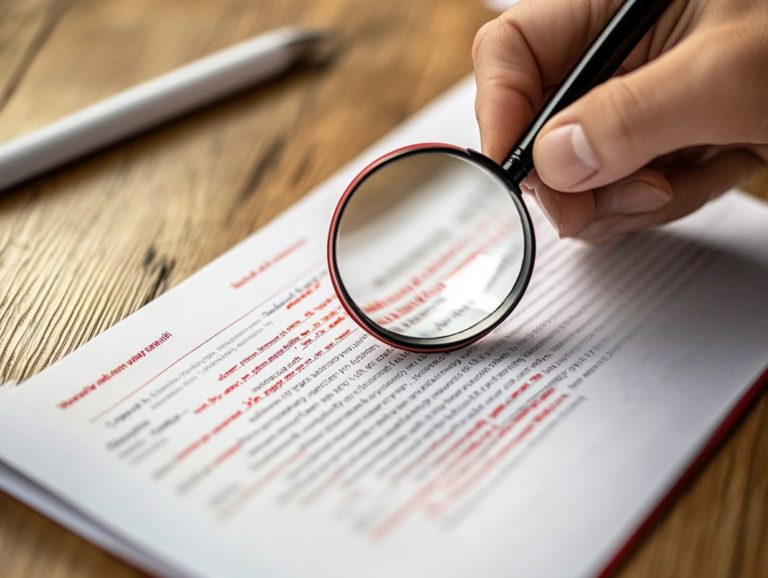5 Licensing Agreement FAQs: Common Questions Answered
Licensing agreements hold significant importance in the realm of intellectual property, acting as a vital link between creators and businesses.
As an inventor, artist, or entrepreneur, grasping the intricacies of these agreements can elevate your capacity to monetize your creations while safeguarding your rights.
This article tackles common inquiries surrounding licensing agreements, delving into their purpose, essential components, various types, and potential risks.
By the conclusion, you’ll possess the knowledge necessary to navigate the licensing landscape with complete confidence.
Contents
- Key Takeaways:
- 1. What Is a Licensing Agreement?
- 2. What Is the Purpose of a Licensing Agreement?
- 3. What Are the Key Components of a Licensing Agreement?
- 4. What Types of Intellectual Property Can Be Licensed?
- 5. How Are Royalties Calculated in a Licensing Agreement?
- 6. What Are the Different Types of Licensing Agreements?
- 7. What Are the Benefits of Entering into a Licensing Agreement?
- 8. What Are the Risks of Entering into a Licensing Agreement?
- 9. How Long Does a Licensing Agreement Last?
- 10. Can a Licensing Agreement Be Terminated?
- 11. What Happens If a Party Breaches the Licensing Agreement?
- 12. Is a Licensing Agreement Legally Binding?
- 13. Can a Licensing Agreement Be Modified or Amended?
- 14. How Can a Business Protect Itself in a Licensing Agreement?
- 15. What Should Be Included in a Licensing Agreement Checklist?
- Frequently Asked Questions
Key Takeaways:

A licensing agreement is a legally binding contract that grants permission to use intellectual property.
Royalties are typically calculated based on a percentage of sales or a flat fee per unit sold.
Different types of licensing agreements include exclusive, non-exclusive, and sublicensing agreements.
1. What Is a Licensing Agreement?
A licensing agreement is a legally binding contract between you, the property owner, and the licensee. It grants rights to use certain intellectual property, such as trademarks or copyrights, based on specified terms.
These agreements play a crucial role in safeguarding your intellectual property rights as the licensor. They also provide the licensee with the permissions necessary to utilize your property.
Typically, you retain ownership of the intellectual property, but you clearly outline how the licensee can use it. This may include details about royalties, the duration of the license, and any geographical limitations.
The structure of these agreements is essential. Enforceable terms help prevent disputes and unauthorized use, fostering a trustworthy relationship between you and the licensee.
Clarity and specificity within these contracts ultimately strengthen their legal standing in the complex landscape of licensing.
2. What Is the Purpose of a Licensing Agreement?
The primary purpose of a licensing agreement is to empower you, the licensee, to tap into valuable technologies or products. At the same time, it provides the licensor with a framework to commercialize their intellectual properties, creating lucrative opportunities for revenue generation for both parties.
Through these agreements, licensors can unleash the full potential of their innovations. They can reach broader markets without the burden of heavy investments in distribution or marketing.
Meanwhile, you gain immediate access to cutting-edge technologies and established brand recognition, significantly reducing your time to market.
This partnership not only benefits you but opens up amazing opportunities! Legal protections embedded in the agreements ensure that your rights and interests are well safeguarded.
These shared advantages cultivate a vibrant business environment and fuel innovation, motivating creators to share their advancements with you and others in the industry.
3. What Are the Key Components of a Licensing Agreement?
Key components of a licensing agreement typically encompass terms of usage, royalty payments, contract duration, and any exclusivity arrangements that dictate how you can utilize the licensed property.
Each of these elements is pivotal in shaping the dynamic between you and the licensor. For instance, the terms of usage clearly outline the specific ways you can employ the property, ensuring you honor the original intent of the work.
Royalty payments create a financial framework for profit-sharing, which can fluctuate significantly based on market demand and the negotiations you engage in.
The contract terms, including their length and renewal options, are crucial as they define the duration of your rights. Exclusivity arrangements can greatly affect competition and brand visibility, potentially enhancing market value for both you and the licensor.
If you’re interested in learning more about licensing agreements, explore further or contact us for more information!
4. What Types of Intellectual Property Can Be Licensed?
You can explore a variety of intellectual property types to license, including copyrights, trademarks, and software. This opens up avenues for monetizing your assets and expanding your market reach through strategic licensing arrangements.
This approach diversifies your income streams and elevates your brand recognition in a competitive landscape. For example, you can license visual art for merchandise, enriching both your portfolio and the brand’s aesthetic appeal.
Software licensing allows tech companies like yours to profit from innovations without the overhead of manufacturing.
Licensing user-generated content (UGC) taps into audience creativity and fosters community engagement and authenticity.
In today s digital age, leveraging these various licensing avenues gives you the power to build a robust brand identity while forging valuable partnerships that truly resonate with consumers.
5. How Are Royalties Calculated in a Licensing Agreement?

Royalties in a licensing agreement are typically calculated based on set rates, which can be a fixed fee, a percentage of sales, or a combination of both. This structure compensates the licensor (the party granting the license) for the use of their intellectual property.
Several factors can significantly influence these calculations, including current market demand and the chosen licensing model, whether exclusive or non-exclusive.
For example, in technology sectors, where innovation is paramount, exclusive licenses often command higher royalty rates. In the fashion industry, non-exclusive agreements are more common, typically resulting in lower rates due to heightened competition.
Specific terms like payment schedules and performance milestones can impact the final figures, highlighting the necessity of a tailored approach when crafting royalty agreements.
6. What Are the Different Types of Licensing Agreements?
Various types of licensing agreements are available, including content licensing, software licensing, and agreements that offer sublicensable rights. However, it’s important to be aware of some common misconceptions. For instance, understanding the 5 myths about licensing agreements can help clarify how each is crafted to meet the distinct needs of both the licensor and licensee while accommodating a range of exclusive terms.
Take content licensing, for example; it’s invaluable for entertainment companies. It allows them to secure distribution rights for films and music, enabling them to monetize their creative assets while preserving control over their work.
On the flip side, software licensing caters to the technology sector, granting users the rights to utilize software without transferring ownership. This is vital for maintaining both security and legal compliance.
Sublicensable rights can also be a game changer, giving companies the power to broaden their reach by allowing partners to share approved content or technology. This paves the way for joint ventures and collaborative projects.
These agreements exemplify the adaptability of licensing models, tailored to meet the varied demands of different industries.
7. What Are the Benefits of Entering into a Licensing Agreement?
A licensing agreement can unlock amazing opportunities for you, like the potential to generate revenue, boost your brand’s power, and gain legal protections that safeguard your intellectual property rights. This helps ensure sustainable business growth.
By collaborating with established brands, you can significantly amplify your market presence, tapping into previously unexplored customer bases without the hefty costs associated with full-scale distribution.
Take, for instance, a clothing manufacturer; by licensing a popular character brand, you can leverage its appeal to drive sales while sharing marketing responsibilities.
As a licensee, you gain access to tried-and-true products and a well-established reputation, translating into higher profit margins and a faster route to entering the market.
Both parties enjoy the benefits of legal frameworks that protect against infringement, ensuring that your investments are secure and fostering trust in long-term business relationships.
8. What Are the Risks of Entering into a Licensing Agreement?
Licensing agreements provide substantial benefits but also come with risks. Potential breaches of contract, compliance regulation issues, and tricky negotiations can lead to unfavorable terms for either party.
These risks can manifest in various ways, such as legal disputes from misunderstandings or violations of intellectual property rights, which can be financially devastating. Without careful checking, you may unintentionally violate local laws or industry standards, leading to penalties or damage to your reputation.
To navigate this complex landscape, prioritize clear communication and detailed documentation during negotiations. Make sure that all expectations are explicitly outlined. Conducting careful checking is essential, as it helps identify potential red flags before entering into an agreement, ultimately safeguarding the interests of everyone involved.
9. How Long Does a Licensing Agreement Last?
The duration of a licensing agreement varies greatly, typically defined by specific timeframes in the contract terms. You might find clauses for renewal or reassessment to cater to your business needs and changing market conditions.
Several factors contribute to this variability. The type of intellectual property be it patents, trademarks, or copyrights has its own market dynamics and legal considerations. The nature of your business relationship with the other party is also important. Collaborative ventures may require shorter terms for flexibility, while exclusive arrangements tend to be longer due to greater commitment.
Ultimately, the level of exclusivity you negotiate can significantly impact the total duration of the agreement, as exclusive rights often result in longer contracts designed to protect both parties’ investments.
10. Can a Licensing Agreement Be Terminated?

A licensing agreement can be terminated under specific conditions outlined in the contract, usually tied to breaches or non-compliance. Common reasons for termination include:
- Non-payment of fees
- Failure to deliver products or services as stipulated
- Violations of intellectual property rights
It s vital for both parties to fully grasp these implications, as unexpected termination can lead to substantial financial losses and disrupt operations. Review and negotiate termination rights from the outset to ensure they are enforceable and mutually agreeable.
Engaging in these discussions often involves legal counsel to clarify ambiguities in the contract, empowering both parties to prepare for potential disputes and establish clear guidelines for a smooth exit if necessary.
11. What Happens If a Party Breaches the Licensing Agreement?
If there is a breach of a licensing agreement, you may seek legal recourse, which could include monetary damages or equitable remedies as dictated by contract law.
The specific terms laid out in the agreement, like protection from financial loss if the other party breaches the agreement and dispute resolution procedures, can significantly bolster your position when seeking redress.
These legal protections offer a structured framework for addressing grievances, ensuring you fully understand your rights and obligations. You can also seek injunctive relief to stop unauthorized use of licensed material, effectively safeguarding your interests.
By understanding these legal mechanisms, you can manage the risks associated with potential breaches more effectively, creating a more secure licensing environment for your business.
12. Is a Licensing Agreement Legally Binding?
A licensing agreement is considered legally binding if it meets the necessary legal requirements and follows applicable contract law. This ensures that both parties are committed to the agreed-upon terms and conditions.
To achieve this, essential elements must be present. For instance, both parties agreeing is essential, confirming that they willingly enter into the agreement without any form of coercion.
The value exchanged between the parties also plays a crucial role, reflecting a tangible benefit for each side.
It s important for both licensors and licensees to have the legal capacity to engage in such agreements, meaning they are of sound mind and of legal age. Enforceable agreements protect the interests of both parties, safeguarding against potential disputes while ensuring that rights and responsibilities are clearly defined and upheld.
13. Can a Licensing Agreement Be Modified or Amended?
A licensing agreement can be modified or amended, but it requires both the licensor and licensee to agree, along with formal documentation to ensure everything is clear and enforceable.
The amendment process often begins with an open discussion about the proposed changes. This allows both parties to voice their needs and concerns. It’s essential that any alterations are thoroughly negotiated to maintain a healthy working relationship and to avoid potential disputes.
Documenting these modifications in writing establishes a clear record of the new terms. It also reinforces the legal standing of the agreement. Proper documentation is crucial, as it ensures everyone is on the same page, preventing misunderstandings that could stem from verbal agreements or assumptions.
14. How Can a Business Protect Itself in a Licensing Agreement?
To protect yourself in a licensing agreement, ensure that your ownership rights are clearly defined, compliance regulations are strong, and legal protections are embedded within the contract terms.
Along with these foundational elements, conducting thorough due diligence is vital for understanding the risks and benefits of the agreement. This means researching the other party’s financial stability and reputation in the market.
Negotiating favorable terms that address limits on the use of intellectual property can prevent unwanted exploitation. It’s also essential to understand the implications of legal protections, as these can significantly influence the enforcement of your rights and responsibilities in disputes.
By adopting a comprehensive approach that encompasses these strategies, you can better safeguard your interests and navigate the complexities of licensing agreements with confidence.
15. What Should Be Included in a Licensing Agreement Checklist?

A comprehensive licensing agreement checklist should cover essential contract terms, compliance regulations, specified ownership rights, and clear definitions of the rights and responsibilities for both parties.
It should also outline the duration of the licensing agreement, fee structures, and conditions for renewals or terminations. By documenting every detail, you enhance mutual understanding and pave the way for a smoother negotiation process.
With a well-structured checklist, both parties can significantly reduce the risks of misinterpretation. This allows them to focus on collaborative goals rather than potential disputes. Such clarity fosters trust, making it easier to navigate any future changes or challenges that may arise during the partnership.
Frequently Asked Questions
What is a licensing agreement?
A licensing agreement is a legally binding contract where one party grants permission to another to use their intellectual property, like trademarks, patents, or copyrights, for a specific purpose and period.
What are the common types of licensing agreements?
The five common types of licensing agreements are exclusive, non-exclusive, sole, direct, and sub-licensing agreements. Each type has unique terms that define the scope of the agreement and the rights and responsibilities of both parties. For entrepreneurs looking to navigate these options, exploring licensing agreement strategies can be particularly beneficial.
How long does a licensing agreement last?
The duration of a licensing agreement varies based on the agreed terms. It can last from a few months to several years, with options to extend or renew if both parties agree.
What are the benefits of a licensing agreement?
Licensing agreements offer several benefits. Licensors can earn extra revenue by allowing others to use their creative works or ideas.
Licensees gain access to valuable resources and expertise without heavy investments or research costs.
What happens if one party violates the licensing agreement?
If one party violates the licensing agreement, the other party can take legal action. This may include enforcing the agreement and seeking damages.
Both parties should clearly define the terms to avoid conflicts or misunderstandings.
How can I terminate a licensing agreement?
A licensing agreement can be terminated by mutual consent. It can also end when the agreement expires or if one party fails to comply with the terms.
Including termination provisions in the agreement protects both parties’ rights and interests.
Understand your rights and seize every opportunity with a well-crafted licensing agreement!






